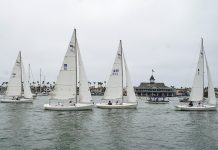Ahoy!
There is one part of the seven seas that is especially not for the faint hearted, and few sailors have attempted to sail these waters that are known as the most dangerous and roughest in the world. It is a huge challenge for sailors, but presently a sailboat from Newport Harbor just completed this passage and is now floating in the South Atlantic about 600 miles off Uruguay.
I am talking about the infamous Cabo de Hornos, commonly referred to as Cape Horn, Chile, which is the most northern section of the Drake Passage but not the most southern territory in South America. That would be the Diego Ramirez Islands, on the southern side of the Passage.
Cape Horn is known for very strong winds, steep waves, icebergs, and penguins. Every sailor crossing from the Atlantic to the Pacific Ocean or vice versa had to round the Cape until the Canal de Panamá (Panama Canal) was built creating a safer and faster shortcut.
Last Saturday during my nationally syndicated radio show, Brad Avery, who is the director of Orange Coast College’s Sailing and Rowing Base, called into my radio show from the South Atlantic via a satellite phone. Brad is aboard OCC’s flagship sailing vessel the Alaska Eagle that is a 65-foot custom Sparkman & Stephens completed in 1977, and proudly hails Newport Harbor as her home port at the OCC Sail Base.
Brad told the listening audience that the Alaska Eagle has seven students and four staff aboard, and they are now in the South Atlantic after rounding Cape Horn. The sail was no small feat with 30 to 35 knots of wind and lots of water spraying across the deck. The students are experienced sailors who had to prequalify for this leg of the voyage and realize an experience of a lifetime.
The boat departed Newport Harbor in October, bound for Easter Island on Leg 1 of an eight-leg voyage. Now the crew is sailing the boat from South Georgia Island to Buenos Aires, Argentina, and the weather is an important factor in the actual time this leg will be completed on their float plan.
Brad explained that the water temperature is so cold that the crew refers to the seawater as molten lava if anyone falls overboard. It would be very difficult to turn the boat around and recover anyone in the water before hypothermia became fatal, so the crew wears safety harnesses up and down the deck, for example to make sail changes.
The boat, with more than 500,000 miles of travel under her keel, is specially equipped for such a voyage, and all the crew is given a very detailed checklist of gear that they are required to bring aboard. Cold-weather gear and boots are a necessity for survival while sailing in these waters, but dressing in layers of clothing is the key to staying warm.
Very few sailors from Newport Harbor will have the experience of rounding Cape Horn. Therefore, I tip my Captain’s hat to Brad and the OCC’s crew for offering a variety of voyages for sailors aboard the Alaska Eagle whether rounding the Horn or sailing in the Transpac.
Closer to home is our infamous Point Conception to the north, which can be a nasty area to cruise for any recreational boater. I have been cited in boating articles as one of the most experienced delivery Captains to tackle Conception on a regular basis. However, I can think of a few other local boaters – like fuel dock owner Gary Hill and yacht management expert Mark Silvey – who are very experienced with Conception’s ill temper as well.
Many local boaters only cruise in the waters off Southern California as they do not want to round Point Conception or they are held back from the rounding because of time restraints. Other boaters have heard the stories, and they simply do not want to tempt the Sea Gods who can turn the Point into a nightmare in only minutes. I have seen Point Conception at its worst, and I have been thrilled a few times when the seas were perfectly calm. I mention Point Conception in my weekly boaters’ weather report because you can look to the north to see what is heading south to Newport.
Tip of the week is if you plan on boating south to Mexico, north of Point Conception, or westerly of San Nicolas Island then you need to contact your boat’s insurance agent to expand your coverage for the trip. Your agent can issue an expanded coverage policy for areas that you normally do not sail.
And don’t forget: Tune in to the No. 1 boating radio talk show in the nation, Capt. Mike Whitehead’s Boathouse Radio Show, broadcasting coast-to-coast on the CRN Digital Talk Radio syndicated network every Saturday at noon, Pacific Time and replayed on Sunday at 10 am Pacific. Join Chandler Bell and me as we talk about “all things boating.” You can find the station listings, cable TV channels, live streaming on the Internet, and now available are apps to listen to the show for your iPhone, Blackberry, iTouch, Android, Palm, and Windows Mobile at www.BoathouseTV.com or www.BoathouseRadio.com.
Until next week, Safe Voyages!




